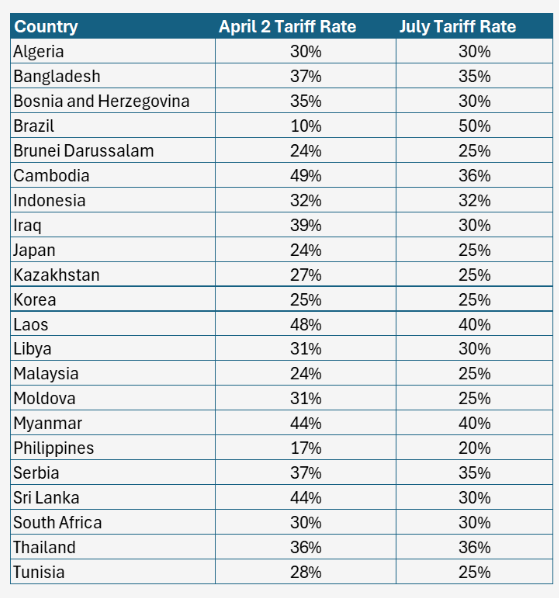Lunes 14 de julio del 2025
President Trump this week issued an executive order deferring his so-called “reciprocal” tariffs from July 9 to August 1, effectively extending the 90-day pause imposed after their brief application for a few hours on April 9 sent financial markets into turmoil. However, the White House is in the process of modifying slightly those elevated tariff rates in a series of letters sent to the following foreign governments over the course of the past week:

Most of the letters add: “These Tariffs may be modified, upward or downward, depending on our relationship with your Country.” The letters outline U.S. pledges to impose additional tariffs on goods transshipped from China through third countries. They also note that the U.S. will match any retaliation by raising tariffs the same amount.
“A Letter Means a Deal.” The letters were sent as the 90-day pause in the “reciprocal” tariffs expired with few trade deals reached. White House trade official Peter Navarro had pledged “90 deals in 90 days,” but to date only an interim deal with the UK has been concluded and made public; a deal with Vietnam was announced via social media post, but press accounts suggest continuing disagreements with Hanoi over its terms.
Consequently, the letters appear to serve as a substitute for negotiated deals. “I just want you to know a letter means a deal,” President Trump told the press early this week. He went on to say that “negotiations were ‘too time-consuming’ and ‘the deals are mostly my deal to them,’ while claiming he could make pacts and that they might come—but would perhaps take years.” The president also mused about hiking his 10% “baseline” tariff to 15% or 20%.
Sec. 232 Tariffs, Too: The letters explain that prospective tariffs imposed under Section 232 of the Trade Expansion Act of 1962 will supersede any reciprocal duties. On that front, the administration this week announced that Section 232 tariffs of 50% will be imposed on copper imports beginning August 1, with Section 232 tariffs on imports of lumber, trucks, aircraft, semiconductors, pharmaceuticals and critical minerals also in the offing—possibly around August 1 as well.
On pharmaceuticals, President Trump told the press he intends to impose 200% tariffs on imported medicines, possibly to be applied in 12 or 18 months. However, the president’s comments are the extent of the administration’s action on the matter so far. Commerce Secretary Howard Lutnick said on July 8 that Section 232 investigations into pharmaceuticals and semiconductors would be concluded by “the end of the month.”
Canada and Brazil drew renewed attention as well, with President Trump posting on July 10 that the so-called fentanyl tariffs on goods from Canada will rise from 25% to 35% on August 1. White House officials told the press that this likely hews to the approach in place since March, with the duties applying only to imported goods that are not USMCA-compliant (which is approximately 15% of merchandise imports from Canada today). However, this remains to be confirmed.
On Brazil, President Trump’s letter announcing a 50% tariff cited the legal proceedings against former Brazilian President Jair Bolsonaro as part of its rationale. The duties are being applied under the International Emergency Economic Powers Act and a putative national emergency declared on account of the U.S. trade deficit; how the same authority could be invoked in connection with the legal proceedings against Bolsonaro is unclear. Trump also said he was directing the Office of the U.S. Trade Representative to open a Section 301 investigation because of Brazil’s “continued attacks on the Digital Trade Companies.»



